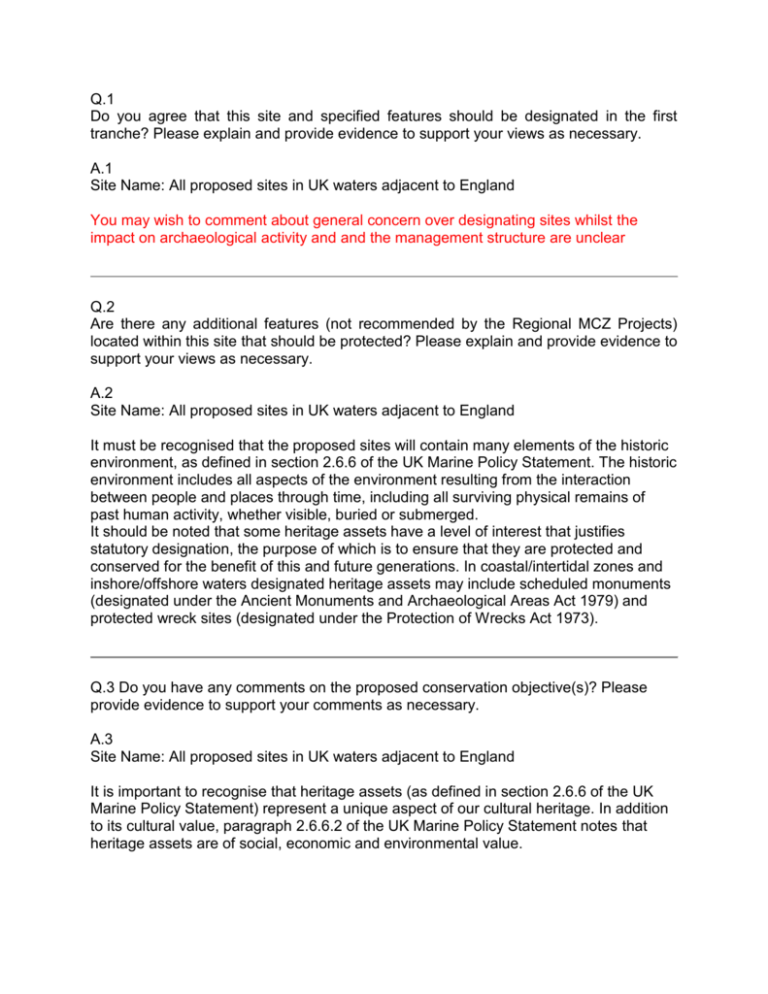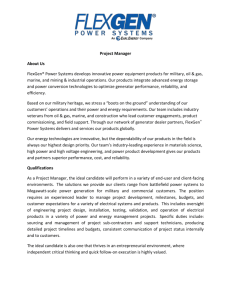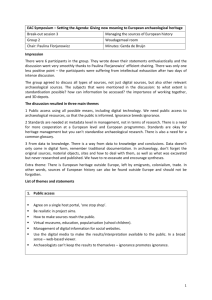Editable Text of Draft Response
advertisement

Q.1 Do you agree that this site and specified features should be designated in the first tranche? Please explain and provide evidence to support your views as necessary. A.1 Site Name: All proposed sites in UK waters adjacent to England You may wish to comment about general concern over designating sites whilst the impact on archaeological activity and and the management structure are unclear Q.2 Are there any additional features (not recommended by the Regional MCZ Projects) located within this site that should be protected? Please explain and provide evidence to support your views as necessary. A.2 Site Name: All proposed sites in UK waters adjacent to England It must be recognised that the proposed sites will contain many elements of the historic environment, as defined in section 2.6.6 of the UK Marine Policy Statement. The historic environment includes all aspects of the environment resulting from the interaction between people and places through time, including all surviving physical remains of past human activity, whether visible, buried or submerged. It should be noted that some heritage assets have a level of interest that justifies statutory designation, the purpose of which is to ensure that they are protected and conserved for the benefit of this and future generations. In coastal/intertidal zones and inshore/offshore waters designated heritage assets may include scheduled monuments (designated under the Ancient Monuments and Archaeological Areas Act 1979) and protected wreck sites (designated under the Protection of Wrecks Act 1973). Q.3 Do you have any comments on the proposed conservation objective(s)? Please provide evidence to support your comments as necessary. A.3 Site Name: All proposed sites in UK waters adjacent to England It is important to recognise that heritage assets (as defined in section 2.6.6 of the UK Marine Policy Statement) represent a unique aspect of our cultural heritage. In addition to its cultural value, paragraph 2.6.6.2 of the UK Marine Policy Statement notes that heritage assets are of social, economic and environmental value. When designating Marine Conservation Zones, DEFRA may have regard to the economic or social consequences of doing so, inclusive of the historic environment, so it is important to precisely define what kind of activities might be considered to adversely affect the condition of an MCZ interest feature, and whether access to, and investigation of, heritage assets are included in this definition. Paragraph 2.6.6.3 of the UK Marine Policy Statement importantly notes that the view shared by the UK Administrations is that heritage assets should be enjoyed for the quality of life they bring to this and future generations. Q.4 Are there any significant reasons for alteration of this site’s boundary? Please explain and provide evidence to support your views as necessary. A.4 Site Name: All proposed sites in UK waters adjacent to England Heritage assets designated under the Protection of Wrecks Act 1973 or the Ancient Monuments & Archaeological Areas Act 1979 comprise spatial management measures that may overlap with proposed MCZs. Heritage assets are a finite and often irreplaceable resource and can be vulnerable to a wide range of human activities and natural processes. Paragraph 2.6.6.3 of the UK Marine Policy Statement notes that opportunities should be taken to contribute to our knowledge and understanding of our past by capturing evidence from the historic environment and making this publicly available, particularly if a heritage asset is at risk of being lost. In some cases, when considering a MCZ for designation attention should be given to how the boundary of the designated area may need to be reviewed and altered to ensure that opportunities to capture information from heritage assets is not compromised. Q.5 Is there any additional evidence to improve data certainty for features within this site? If yes please provide evidence. A. 5 Site Name: All proposed sites in UK waters adjacent to England Spatial data on designated heritage assets in waters adjacent to England is available from: http://services.english-heritage.org.uk/NMRDataDownload/ Q.6 Are there any additional activities (that may impact the recommended features) occurring within this site that have not been captured within the Impact Assessment? Please provide evidence to support your views. A.6 Site Name: All proposed sites in UK waters adjacent to England The Impact Assessment has not adequately taken account of the effect (economic and social) of MCZ designation on archaeological projects and activities nor addressed the full impacts of designation on heritage assets particularly where recommended MCZs conservation objectives might stop historic environment research, education and public enjoyment. It must be recognised that paragraph 2.6.6.3 of the UK Marine Policy Statement notes the 'view shared by the UK Administrations is that heritage assets should be enjoyed for the quality of life they bring to this and future generations, and that they should be conserved in a manner appropriate and proportionate to their significance. Opportunities should be taken to contribute to our knowledge and understanding of our past by capturing evidence from the historic environment and making this publicly available, particularly if a heritage asset is to be lost.' Q.7 Do you have any new information on costs to industry not covered in the Impact Assessment, that would be directly attributable to MCZs as opposed to costs stemming from existing regulatory requirements, or evidence that suggests the need for changes to the methodologies or assumptions used in estimating costs (including in relation to fishing displacement)? If yes please provide evidence. A.7 Site Name: All proposed sites in UK waters adjacent to England Written proposals in the Impact Assessment with respect to rMCZs state that 'it is anticipated that archaeological surface recovery of artefacts and full site excavations will be prohibited.' Not only does this proposal conflict with the view shared by the UK Administrations set out in A.6 above, but there will also be non-monetized negative costs to society if archaeological material evidence is lost because intervention is prohibited. Q.8 Do you have any new information that was not available or used in the Impact Assessment to inform or quantify the value the benefits of MCZs? A.8 Site Name: All proposed sites in UK waters adjacent to England Paragraph 2.6.6.2 of the UK Marine Policy Statement notes that the historic environment of coastal and offshore zones represents a unique aspect of our cultural heritage. In addition to its cultural value, it is an asset of social, economic and environmental value. It can be a powerful driver for economic growth, attracting investment and tourism and sustaining enjoyable and successful places in which to live and work. There is an evidence gap in the Impact Assessment for the 'Historic Environment' sector has not been adequately addressed; there will be costs of MCZ designation with regard to capturing evidence from the historic environment. There will also be non-monetized negative costs to society if material evidence is lost because intervention is prohibited (as indicated in paragraph 3.2.22 of the Impact Assessment). The best estimated annual cost with regard to designated heritage assets is likely to be £0.5m/yr (in the absence of management measures coupled with potential material loss). Paragraphs 3.2.20 to 3.2.38 of the Impact Assessment fails to adequately take into account heritage assets that do not have statutory protection: there are many thousands of archaeological sites around our coasts that have been positively identified as holding a degree of significance. The view shared by the UK Administrations is that heritage assets should be enjoyed for the quality of life they bring to this and future generations, and that they should be conserved in a manner appropriate and proportionate to their significance. General Comments Q.9 You may wish to provide comments on other aspects of this consultation such as evidence requirements, identification and treatment of high risk sites. Where you disagree with the approach taken please provide evidence to support your views. A.9 i) I note that the exact management measures required for each site will not be known until after designation. In considering management measures for each MCZ, it will be important to ensure that marine & coastal archaeological activities targeted at heritage assets are permitted to continue, particularly where a marine heritage asset is considered to be at risk and intervention is required. Such activities will be undertaken in accordance with the rules annexed to the 2001 Convention on the Protection of the Underwater Cultural Heritage. It must be noted that paragraph 2.6.6.3 of the UK Marine Policy Statement provides the recognition that heritage assets should be conserved in a manner appropriate and proportionate to their significance. This is further underpinned in the UK Marine Policy Statement which notes the need to record and advance our understanding of of heritage assets for this and future generations. i) In considering management measures for MCZs, I wish to highlight paragraph 2.6.6.3 of the UK Marine Policy Statement which notes that the view shared by the UK Administrations is that heritage assets should be enjoyed for the quality of life they bring to this and future generations. ii) It is important to note that areas of the seabed designated (in England) under the Protection of Wrecks Act 1973 and the Ancient Monuments & Archaeological Areas Act 1979 should be recognised as 'Other Spatial Measures' for the purposes of conserving and improving the marine historic environment. iii) I note that although proposed Reference Areas (RAs) identified by the Regional Projects will not be taken forward in the first tranche of MCZs, a 'fresh look' will be taken '...at requirements for RAs including size, number, location and management measures particularly in relation to long standing non-commercial traditional activities'. I suggest that 'non-commercial traditional activities' be defined and that adequate attention is given to archaeological projects aimed at capturing evidence from the historic environment and making this publicly available. Paragraph 3.2.22 of the Impact Assessment (IA) states that 'it is anticipated that archaeological surface recovery of artefacts and full site excavations will be prohibited' in RAs. Further, paragraph 3.2.25 of the IA states that 'if archaeologists respond to the prohibition by seeking alternative sites for archaeological excavation elsewhere, this could result in additional costs to the sector'. While a primary principle of archaeological investigation has been missed in relation to the location of archaeological remains, the deficient judgments expressed in the IA (concerning archaeological heritage) conflict with the view shared by the UK Administrations, as set out in the UK Marine Policy Statement, that heritage assets should be enjoyed for the quality of life they bring to this and future generations, and that they should be conserved in a manner appropriate and proportionate to their significance I note that the IA states DEFRA's intention to commission further research on 'cultural services' as it is a recognised evidence gap in completing the IA exercise. Archaeological heritage must be included in the definition of 'cultural services' particularly as heritage assets (as defined in section 2.6.6 of the UK Marine Policy Statement) represent a unique aspect of our cultural heritage.








